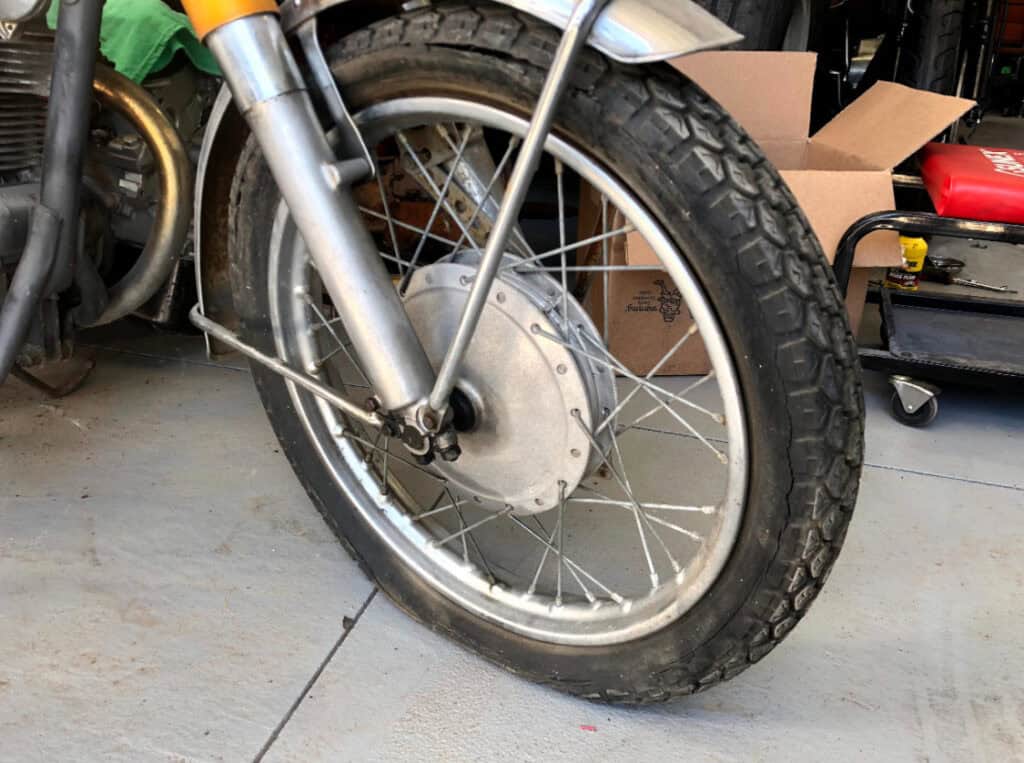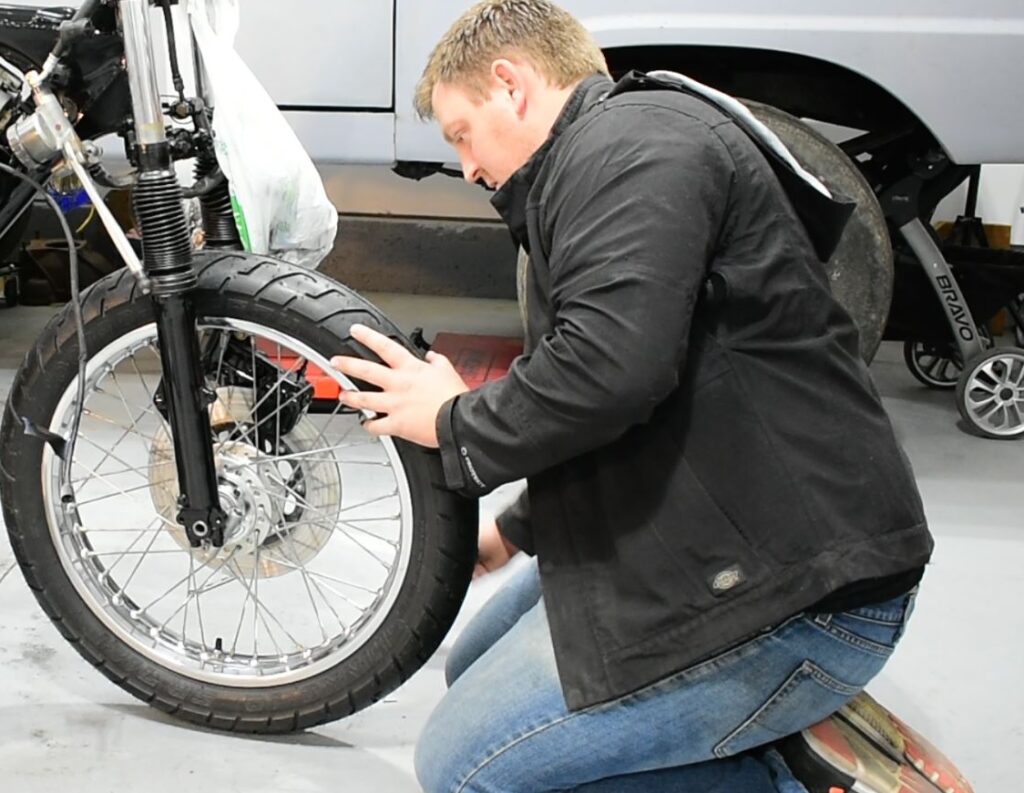
It’s probably safe to say that most of us motorcycle riders have occasionally been caught in a situation where we find ourselves with low tire pressure. And it’s usually at the least convenient time, too.
There are several reasons that would cause a motorcycle tire to lose air pressure. Because of this, it can often leave a motorcyclist frustrated since it’s usually not obvious as to why it’s happening.
Why do motorcycle tires lose air pressure? The most common reason why motorcycle tires lose air pressure is because of changes in outside temperatures. Motorcycle tires can also lose air pressure because of a faulty valve, a bent rim, worn tires such as bald spots or cracks, or because a small hole was punched through it.
Having owned almost two dozen motorcycles myself, lost pressure in a motorcycle tire is not new to me. In this article, we’ll explore the various reasons why motorcycle tires lose air pressure and discuss practical tips for addressing and preventing this issue.
Why Motorcycle Tires Lose Air Pressure
Sometimes low tire pressure isn’t always obvious and most motorcycles don’t come with a tire pressure light on their instrument cluster. Other times, it’s completely obvious either by the way the tire looks or by the way the motorcycle is handling on the road. Either way, having the right tire pressure is extremely important and addressing the issues could be a matter of your safety.
The first and most common reason a motorcycle tire loses pressure is because of temperature changes outside. Generally, a motorcycle tire loses about 1 PSI for every 10° drop in outside temperatures. That may not seem very significant, but when you go from summer to winter where it’s about a 70° difference, that means your tire is about 7 pounds too low.
On the flip side, too hot of temperatures can also cause a motorcycle tire to lose pressure though not through the same laws as cold air. If your tire is over-inflated and happens to sit outside for a few hot summer days, the pressure inside will expand and possibly rupture a hole in the tire.
In Utah where I have lived most of my life, it can get close to zero degrees some winters while during the summer it can get up to 110. That being said, I’ve seen the havoc temperature changes can do to motorcycle tires.
Though not as common, a faulty valve can also cause a motorcycle tire to lose pressure. This is usually due to it being incorrectly connected to the tube canal (which would probably be a manufacturer problem) or that the pin inside the top of it got permanently bent somehow which would cause air to continuously flow out. That’s why it’s important to always have a cap on the valve.
Motorcycles come with two types of tires: tubed and tubeless. There are a lot of motorcycles nowadays that have tubeless tires which means the tire you see is what’s actually holding in the air. This is because it suctions to the rim. A bent rim can easily cause the tire to lose air pressure because the tire isn’t able to suction to the rim properly. Even the smallest of bends caused by potholes or other road obstacles can cause this.
There’s a reason motorcycle tires have a life expectancy; too worn of tires aren’t safe for the rider because they’re no longer reliable and don’t have any traction. A worn out tire, or a tire with an obvious bald spot, can cause a motorcycle to lose tire pressure because it’s extremely susceptible to forming holes. Worn tires should be replaced immediately.
It’s also possible that a hole was punched through the tire at some point while out for a ride. Holes are more commonly caused by something hard like nails since the rubber on motorcycle tires are pretty tough and made to withstand most road debris. Nails usually stay in the tire, so inspect your tire to see if any nails or other debris has nestled itself inside the tire.
How Much Tire Pressure Loss Is Normal?
Every motorcycle tire will lose pressure over time. That’s simply how tires function. Knowing the difference between normal air pressure loss and what’s considered too much may help you be a bit safer out on the road.
A motorcycle tire naturally loses some of it’s air pressure because of a process called osmosis (also known as permeation). This means that air has the ability to pass through the rubber particles of the tire at some point, similar to how helium and air escapes a balloon over time.
Though different makes and models of motorcycles call for different types of tires, the average tire pressure loss for motorcycles is about 1-3 PSI per month. This is why it’s important to regularly check your tire pressure to ensure you keep up with the natural occurrence of osmosis.
As it was stated previously, it’s completely normal to lose about 1 PSI of pressure in your tire for every 10° drop in the outside temperature. That’s often why a lot of car and motorcycle owners end up filling their tires in the fall or winter because of the dramatic temperature change. When it cools down, the air molecules inside the tire condense which is why the pressure becomes lower.
If you live in an area with warm days and cool nights, it’s normal to see lower tire pressure at night then have a normal pressure during the day when the temperatures rise again.
What Happens When You Ride With Low Tire Pressure

Riding with low tire pressure means there will be more surface area of the tire touching the road which ultimately causes more friction between the two. This will cause the tires to prematurely wear out and even lead to tread separation.
A motorcycle engine has to work harder when the tires don’t have the proper tire pressure. Too low of pressure means more surface area the motorcycle has to work with which causes the engine to make up the difference. Ultimately, it can impact your gas mileage and possibly decrease it.
It’s also more difficult navigating a motorcycle with low tire pressure. Less control of the motorcycle means you have an increased chance of getting into some sort of accident.
If you ride on a motorcycle with extremely low tire pressure, you risk ruining the rims of the tires. With the lack of air providing minimal protection between the metal rim and the road, any little bump or hole could easily cause a dent. Motorcycle rims are pretty difficult to repair.
How To Check For Air Leaks
If you suspect you have a tire pressure air leak on your motorcycle that isn’t due to natural temperature changes or osmosis, you should inspect your tire to locate the leak. If you have a tubeless tire, there are a few simple ways you can check to see if you have a slow leak somewhere you’re not aware of.
First, get some sort of solution that easily bubbles such as soapy water. It’s easiest to have the tire off the motorcycle but doable if it’s still attached, you’ll just have to pay closer attention. Mix the soap and water and put it in a spray bottle. Spray the soapy water on the tire tread in sections and let it sit for a few minutes. Any leaks will manifest itself by bubbling up. It’s best to start at holes that were previously mended as those have a higher rate of failing after a while.
You should also check the valve as well as around the tire rim where the tire suctions to the metal. This will help indicate if a bent rim is the problem; similarly, a faulty valve will also bubble if there’s a leak coming from there.
There are plenty of tire repair kits out there that allow you to puncture a hole bigger than the original and put a plug in it. Though it may seem enticing, I would recommend taking the motorcycle tire into a tire shop and have them repair it the right way. That’s a fix you don’t want to get wrong.
If you have tubed tires, finding a possible leak yourself can be a lot more difficult. Accessing that inner tube is almost impossible unless you have a tire mounting machine. The only way to really tell if your tubed motorcycle tire is losing more pressure than it should is by simply taking it to a tire shop.
Conclusion
The usual cause for a motorcycle tire to lose air pressure is due to changes in the outside temperature. A tire losing air pressure can also be caused by a faulty air valve, a bent rim, or a hole somewhere on the tire. By staying vigilant and regularly checking your tire pressure, you can mitigate the risks of low tires and ensure optimal performance and safety on the road.
Please feel free to reach out to me personally or comment below with any questions you may have, I’m more than happy to help!
